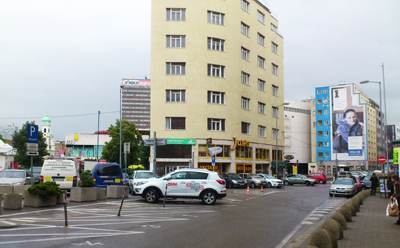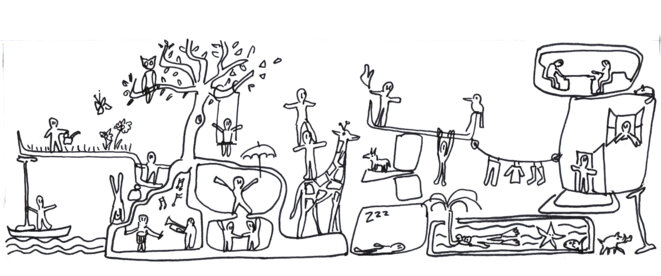Urban metamorphosis*

There was, in the European cities, the awareness of the necessity of protecting the capital that the historic centers forms. And we improved public squares there. There was, before the last war, the will to create parks, places of relaxation, spaces where the city-dweller would find the conditions of a lifestyle. Formerly, marketplaces wore partially the collective life, whereas the squares of the church or of the city hall, the royal squares celebrated the symbols or the power. What about today?
The decades after the war were not fertile in this domain. They were rather the ones of the demolition. We inherited from abandoned sites due to functional visions, invaded by automobiles or simply non-existing as it was in the big social real estates.
It is on the spaces which arise from it that the European cities work at the moment. It is a question of repairing, of taking care. The conventional urban spaces (the squares the gardens…) are not only concerned but also all the places as streets and crossroads, infrastructures and banks of rivers, the complexes of the 60s and the popular districts of the 19th century, the places of transport, the commercial sectors …
We passed of the creation of places of relaxation in the repair, the regeneration of the traumatized circles*.
Why must we improve the quality of the space of the urban life?
Because we are not any more in a time of demonization of cities and because there is on one hand a real demand and on the other hand the necessity. Indeed, cities are territories of life or production. In this way, the practices, the populations, the techniques evolve and we must be capable of accompanying these changes. On the other hand cities are one of the places of expression of the tensions of the urban society, these going of the daily use of spaces until moments of extreme tension.
But the urban spaces are also necessary for the functioning of cities and contain networks, welcome transport lines, allow the deliveries, the mobility …
The urban spaces also translate in the facts the public policies as the handicap, the nature in town, the light, the temporality.
Quite at the same time functional spaces and social spaces, they wear the contradictions of the social life, its difficulties but also its wealth. Then, improve them does not consist only of aesthetic considerations but we have to attack complex, changeable, singular, contemporary circles and thus take into account certainly of a liabilities but also their qualities. And rather than to speak about transformation, it is a question of insuring the metamorphosis because, of what is there, has to be born something transfigured who supposes to anchor in the context and to feed on it*.
How to make then? There is no rigorous and scientific method but it is essential to start from the processes of production of the urban fabric and to make of the learned do-it-yourself.
We approach a full of contradictions environment: between the pedestrians and the cyclists, the young people and the old men, the storekeepers and the residents, the cars and the buses … Rather than to evade this, to make as if it did not exist, it is necessary to look for them, to bring to the foreground them and " to put on the table ", to show so the complexity of the subject to the actors, the users or the producers of the urban, so that each becomes aware of it. It supposes the implementation of a very strong project steering of the public logic.
In a way, we have to mobilize the dynamics of the territory.
The outlines of the reality, of the context then take shape, made by points of view accumulating objective analyses and particular logics. It is necessary to share them during meetings which restore the subject, being attentive to the fact that the language, the used documents are understandable for all. We have to admit to move forward without certainties, accepting the unpredictable, being attuned, facilitating the appropriation of the problems rather than hiding them.
The sharing of the qualities and the defects of a site, of the numberous expectations and the contradictions makes then necessary the choice. It can be made from the production of some hypotheses of possible evolution and mobilizes politics. We so give place to the expression of the conflicts onto a space and allows their regulation in the service of its metamorphosis, of its virtuous evolution: we move forward!
We do not obtain at this stage a finished product but a kind of program giving orientations concerning the practices, the schedules, the objectives and which also integrates the data of the sectorial public policies. A professional designer then has to translate this corpus into project, which is the proposal of a transfigured space allowing a certain coexistence.
The process of mobilization and research of the expression of points of view has to continue in every stage of the study of the project and to be maintained, chanted every time by the political choices. The result of the metamorphosis is then at the crossing of the fertilization of the qualities of the context, the mobilization of the users, political orientations and competence of the conceiver.
For all that, there is no applicable method everywhere and the mobilization of the actors of the territory needs adaptations to every context.
We spoke of new projects but it is also necessary to protect the existing activities, when we build a new area but also when there are works for example. The initiative takes an importance in the time limited of the transformations but it avoids damaging the urban activity.
One of the consequences which joins the necessity of going to the contact of the actors and the populations is the need for information, for participation.
We are far from the idea that it would be necessary to imagine, to invent a new city model. It is a question of developing those who exist with the multiple identities, their new ways of functioning and their martyred elements.
The stake is to succed in making of the process a lever to make live together the multiple individualities.
* Chris Younes, philosopher



